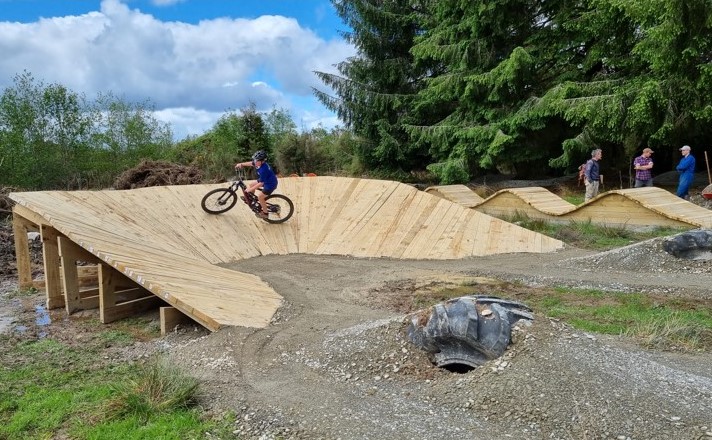

Case Study: Funding Supports Student-Led Project

The Tū Manawa Active Aotearoa Fund (TMAA) was the missing piece of the puzzle which ultimately helped in finishing the school’s project, providing funding for the bikes.
Paparoa Range School may be split across two sites in Dobson and Blackball, but over the last two years has come together to build one cool bike track on the Blackball site, creating a great opportunity for the tamariki and rangatahi to learn new skills right in their own backyard.
Burrowed up in the Grey Valley on the South Island’s West Coast, the small school with a combined student roll of only 75 - from 5 to 13 years old - finds it easier to encourage individual sports which make use of the local environment, such as rock climbing, rafting and kayaking.
Because of this, Karen Wells, a teacher aid at the school discussed with the students of Paparoa School what they wanted and came to the conclusion - a bike track. Karen took the students' ideas, designs and drafts to a community meeting in May of 2021, which is where the project all started.
Karen became one of the project managers of the new bike track and says two years later that “we now have an activity that all our students can utilise and get joy out of.”
“The main goal of our project is to provide our students with the necessary skills to eventually ride the Paparoa Range Great Walk and Mountain bike track and the Pike River Downhill track.”
Community Led Development Programme (CLDP) Partnership Manager Zane Smith, who was one of the project managers backed this up, saying “the kids are surrounded by amazing trails that they aren't really touching.”
The project was largely student led from beginning-to-end and had a large focus on youth involvement with the support of the community. This meant that the tamariki and rangitahi involved “got the opportunity to collaborate with adults in an adult's world” adds Zane.
“We’re finally listening to our tamariki who are experts in play and recreation,” says Jack O’Connor, Sport Canterbury’s West Coast Regional Manager. “They see things aspirationally, not confined by resources regulations and time which impact our decision making.” he said.
Zane also says that because the students had such a large voice in the project right through, the response and willingness from the community to help was huge.
Karen believes the community and families at the school “came together and spent hundreds of hour volunteering and there was support from local businesses who donated raw materials and infrastructure to assist with the building of the track.”
A large chunk of the bike track was completed by September last year but was not officially opened October 2023. Zane explained that the bike track is a flow track rather than the more common pump track, as skills developed on a flow track are more suitable for some of the West Coasts bigger trails.
An issue the project was faced with once the bike track was completed, was how the kids were going to use the track.
“When we have got this beautiful bike track and some of the kids have got bikes but most of them don’t, that was an interesting conundrum for us.” Zane said.

Prior to the TMMA funding, the Department of Internal Affairs was providing community funding to support high deprivation communities, which Blackball falls under.
The TMAA fund at Sport Canterbury provided Paparoa Range School $5,000 after hearing about the project from Karen Wells who filled out the funding application. With the funding the school and community were able to purchase 20 bikes for the students to use, which they recently went on school camp with.
Zane says, “before we secured the funding, those kids were running the bike track.”
Jack adds that the money funded will have a larger impact than just on the project. “Activating spaces is part of our commitment to the Grey District Council so the impact of the TMAA support has a greater reach than just the students and the wider community who has access outside of curriculum time.”
The school is also implementing a bike maintenance programme, to ensure the bikes are being kept in good condition, enlisting the help of local volunteers to help with maintaining the bikes.
“The crew are really focused on storage, cleaning and the maintenance which is really nice so there is a sense of pride,” Zane says.
Karen says that “we will also teach the children how to conduct pre-riding checks on the bikes before rising on our mountain bike track” and that there is storage on the school site to ensure the bikes are kept safe.
“The benefits to our students through having this wonderful resource in their backyard are happiness through improved health and well-being, self-confidence, perseverance, a sense of achievement at being able to master tricky parts of the track and pride in what they have achieved. All of which we hope will transfer across into a positive attitude towards their learning and help alleviate problems within the playground.”
Karen also says that the project benefitted the tamariki and rangatahi’s mindsets, as she maintains that "with a positive mind set and hard work anything can be achieved.”
“I believe that this is probably one of the most significant realisations that our students can take away from our project, they were all part of it from design to the hard graft.”
Zane believes the benefits will spread well beyond the school and local community. “I would imagine there is going to be two, maybe three more flow tracks built around schools on the west coast as a result”. He also says a “really interesting part about it is the buzz from other towns.”
“With this project I feel we have more than nailed it.”

